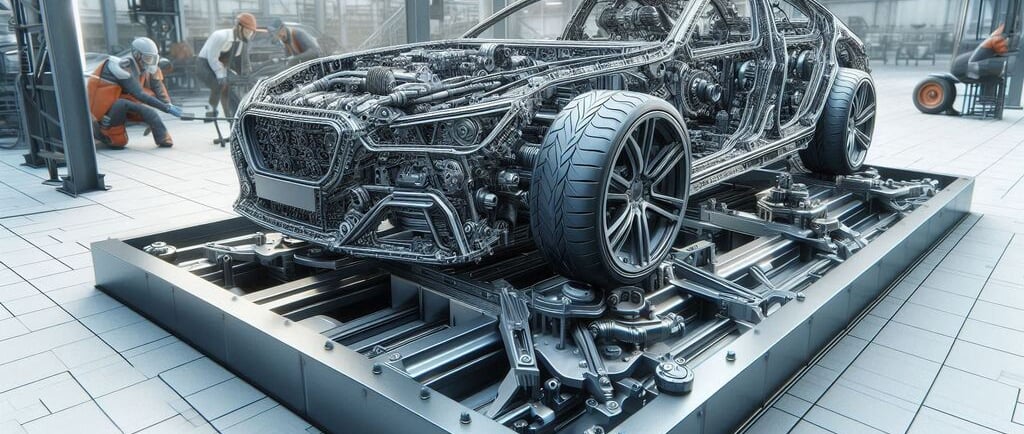Frame: Structural base supporting the vehicle.
When you think about your vehicle, you probably imagine the engine, wheels, or body shape.
CHASSIS AND FRAME PARTS
11/13/20244 min read


Understanding the Vehicle Frame: The Structural Base Supporting Your Car
When you think about your vehicle, you probably imagine the engine, wheels, or body shape. But have you ever thought about the part that holds it all together? The vehicle frame is the structural foundation of every car, providing strength, stability, and safety. Without it, your car wouldn't be able to carry its load, withstand impacts, or offer a smooth ride.
In this article, we’ll dive into the role of the vehicle frame, the different types available, why frame maintenance is crucial, and how you can ensure your vehicle's frame stays in top shape.
What is a Vehicle Frame?
A vehicle frame, also known as the chassis, is the skeleton of the car. It’s the sturdy structure that holds and supports the engine, transmission, wheels, and body. Think of it as the backbone of your car, giving it form, stability, and a solid foundation. The frame is designed to handle the weight of the vehicle and protect occupants during accidents by absorbing impact forces.
Why is the Vehicle Frame Important?
The vehicle frame plays a key role in many aspects of driving and vehicle performance:
Support: It carries the weight of the car, including passengers, cargo, and all components.
Safety: A well-designed frame can absorb and redistribute impact forces during collisions, protecting the occupants.
Stability: The frame keeps the car steady, enhancing handling and maneuverability, especially on rough terrain.
Knowing about your vehicle’s frame can help you appreciate the importance of regular checks and understand how it affects your driving experience.
Types of Vehicle Frames
Understanding the types of vehicle frames can help you make informed decisions, whether you're purchasing a new vehicle or just curious about your car’s structure. Here’s a look at the most common frame types:
1. Ladder Frame
The ladder frame is one of the oldest and simplest designs, consisting of two long beams connected by cross members. It resembles a ladder, hence the name. This frame type is strong and durable, making it ideal for trucks, SUVs, and heavy-duty vehicles.
Benefits:
High strength, suitable for heavy loads.
Durable and resistant to impact.
Drawbacks:
Heavier than other types.
Limited flexibility, which can affect handling in smaller cars.
2. Unibody Frame
The unibody frame is a more modern approach where the body and frame are integrated into a single piece. Most cars today, including sedans, hatchbacks, and small SUVs, are built with a unibody frame due to its lightweight design and superior handling.
Benefits:
Lightweight, which improves fuel efficiency.
Better handling and safety in smaller vehicles.
Drawbacks:
Less durable under heavy loads.
More difficult and costly to repair after major damage.
3. Backbone Frame
The backbone frame is a tubular structure often used in sports cars and some off-road vehicles. It resembles a backbone and provides extra rigidity.
Benefits:
Great for performance-focused vehicles.
Offers superior handling on rough terrain.
Drawbacks:
Limited space for other components.
Less common, meaning repairs can be costly.
Each type of frame has its own advantages, and the choice often depends on the vehicle’s purpose. For example, a ladder frame is ideal for vehicles carrying heavy loads, while unibody frames are more efficient for city cars and sedans.
Maintaining Your Vehicle Frame: Tips for Long-Term Performance
A strong, well-maintained frame is essential for your vehicle's safety and stability. Here are some practical tips to keep your car's frame in great shape:
1. Regular Inspections
Routine inspections are the best way to identify and address frame issues before they become severe. During your regular car check-ups, ask your mechanic to examine the frame for signs of damage, rust, or cracks.
2. Rust Prevention
Rust is one of the biggest threats to your vehicle's frame. Exposure to moisture, salt, and chemicals can accelerate corrosion, particularly in colder climates where road salt is used. To prevent rust:
Wash the Undercarriage: Regularly wash your car, especially after driving in salty or muddy conditions.
Apply Rust-Proof Coatings: Use rust-proof sprays or coatings, especially on the frame and other exposed parts.
3. Address Damage Quickly
If you’ve been in an accident or notice any unusual bumps or sounds, it’s best to have the frame inspected immediately. Ignoring minor issues can lead to more severe structural problems that may compromise your vehicle’s safety.
4. Use Caution Off-Road
While it’s tempting to take your vehicle on an off-road adventure, rough terrain can cause severe frame damage. Avoid excessive off-road driving unless your vehicle is designed for it, and always inspect the frame after any off-road trips.
Common Frame Issues and How to Spot Them
The vehicle frame is designed to last, but it can encounter issues over time. Here are some common problems:
Rust and Corrosion: Rust weakens the frame, especially in older cars or vehicles frequently exposed to moisture.
Cracks and Bends: Frame damage from accidents or rough terrain can lead to cracks or bends, which can compromise safety.
Alignment Issues: A damaged frame can throw your vehicle’s alignment off, making steering difficult and leading to uneven tire wear.
Spotting the Signs of Frame Damage
If you experience any of the following, it could be a sign of frame issues:
Unusual Noises: Creaking or clunking sounds from underneath the car.
Handling Problems: Difficulty steering or pulling to one side.
Uneven Tire Wear: If one side of your tires wears down faster, it could indicate frame misalignment.
Conclusion: Why Frame Maintenance is Key to Vehicle Longevity
The vehicle frame is the backbone of your car, supporting its weight and structure while ensuring safety on the road. Understanding its importance and taking steps to maintain it can help extend the life of your car and improve its performance. By performing regular inspections, preventing rust, and addressing issues early, you’ll keep your car’s frame in excellent shape.



